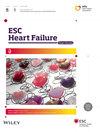Left ventricular function improvement during angiotensin receptor–neprilysin inhibitor treatment in a cohort of HFrEF/HFmrEF patients
Abstract
Aims
Heart failure (HF) patients may lack improvement of left ventricular (LV) ejection fraction (LVEF) despite optimal HF medication comprising an angiotensin receptor–neprilysin inhibitor (ARNI). Therefore, we aimed to identify key predictors for LV functional enhancement and prognostic reverse cardiac remodelling in HF patients on ARNI treatment.
Methods
We retrospectively analysed 294 consecutive patients with HF with reduced (HFrEF) or mildly reduced (HFmrEF) ejection fraction in our ‘EnTruth’ patient registry. LVEF was determined by echocardiography at initiation of ARNI and at 12 months of follow-up. We assessed the predictive value of clinically relevant patient-, HF- and treatment-related parameters in regard to changes in LVEF and all-cause mortality using medoid clustering and the XGBoost machine learning algorithm.
Results
Cluster analysis integrating clinically relevant patient characteristics unveiled four characteristic sub-phenotypes of patients with HFrEF and HFmrEF, respectively. Distinct clusters exhibit a strong (P < 0.05) therapeutic response to ARNI treatment and enhanced LV function. Key patient criteria, such as duration and aetiology of HF, renal function and de novo ARNI treatment, were significantly (P < 0.05) associated with change of LVEF and independently predicted cardiac remodelling. By training various machine learning models on relevant clinical parameters, stratification of LVEF improvement by XGBoost resulted in a high prediction accuracy. The stratification of patients with HFrEF [area under the receiver operating characteristic curve (AUC) = 0.77] and HFmrEF (AUC = 0.70) led to an increased diagnostic accuracy of LVEF improvement in the validation cohort. Using machine learning, the likelihood of cardiac remodelling following ARNI treatment, as indicated by our newly established EnTruth score, was directly associated with absolute LVEF improvement in both HFrEF (r = 0.51, P < 0.0001) and HFmrEF (r = 0.42, P = 0.001). Ultimately, patients with HFrEF and a high EnTruth score have a lower risk of all-cause mortality (P < 0.05 in survival analysis).
Conclusions
Recognition of essential clinical factors by integrating machine learning and cluster analyses may help to identify HF patients benefiting from improvement of LVEF following ARNI treatment. Early identification of those patients with a high response to ARNI treatment may allow a more refined selection of patients benefiting from an early escalation of HF treatment or interventional therapy.


 求助内容:
求助内容: 应助结果提醒方式:
应助结果提醒方式:


